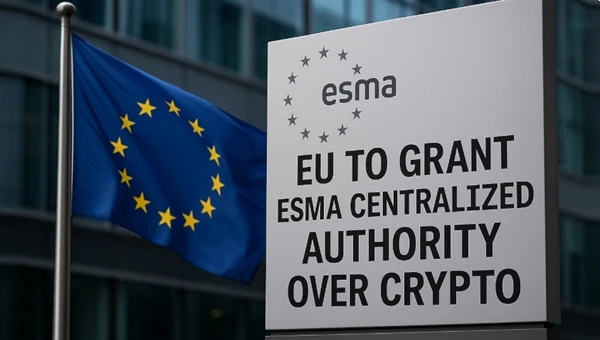

Under the new Markets in Crypto-Assets (MiCA) framework, which became fully applicable in December 2024, national regulators currently hold responsibility over licensing and oversight of crypto asset service providers. The intent was to maintain local control while unifying standards across member states.
Since the regime’s activation, however, divergent interpretations and uneven enforcement have sparked criticism.
To correct those discrepancies, the European Commission now plans to shift oversight of major cross-border crypto entities from national authorities to ESMA. The reform would expand ESMA’s remit beyond equities and bonds into crypto exchanges, custodians, and clearinghouses.
The logic: a single supervisor can ensure uniform application of rules and avoid jurisdiction shopping.
ESMA’s chair, Verena Ross, has argued that current decentralization forces each member state to develop identical expertise independently. Her view is that consolidation would deliver efficiencies and stronger coherence across Europe’s capital markets.

The Impetus: Weak Spots in MiCA’s Rollout
Regulators are raising the alarm since MiCA officially took effect, pointing to persistent systemic gaps. In a joint statement, the European Supervisory Authorities warned consumers that protections are inconsistent across countries and that many crypto products remain outside full regulatory oversight.
The alert specifically cautioned investors about the dangers of dealing with lesser-known tokens or service providers based in nations with more lenient enforcement of the rules.
Further pressure came from the European Systemic Risk Board, which called for additional safeguards around stablecoins issued partly outside the EU. Concerns center on multi-issuer structures whose reserve pools may span non-EU jurisdictions, raising potential liquidity and contagion risks in stress scenarios.
These fault lines have added urgency to calls from France, Italy, and Austria for a stronger EU-level supervisor. Their regulators argue that consistent enforcement is vital to prevent weak jurisdictions from undermining the bloc’s integrity.
Some EU nations are cautious about the regulatory overhaul. Malta’s financial regulator warns that added bureaucracy and lower flexibility could hurt market competitiveness.
Luxembourg has also stated its opposition to centralizing measures that could reduce oversight of national financial hubs, signaling potential regulatory friction for investors operating across borders.
The stakes are high. Smaller states that have historically attracted crypto firms may lose their strategic advantage. Regulators caution that a one-size-fits-all approach may conflict with each country’s market dynamics and risk tolerance, creating potential instability in the sector.
Comparative Perspective
The EU’s drive for regulatory centralization echoes patterns in jurisdictions such as the United States, where the SEC has broad powers over digital assets classified as securities. Centralized supervision has strengthened enforcement and limited the opportunities for market participants to exploit differences between state regulations.
Unlike the U.S., the EU still relies on a fragmented approach, with rules migrating unevenly across member states. Bringing supervision under ESMA could narrow the gap with American practice, but European authorities must carefully balance integration with respect for national financial systems.
For major crypto platforms, a centralized supervisor could simplify compliance by offering a single point of contact. Firms operating in multiple EU countries would no longer navigate 27 different regulators. For instance, Coinbase, a U.S.-based exchange, has leveraged centralized regulation in the U.S. to streamline its operations across states.
However, startups and smaller operators may face higher barriers: meeting ESMA’s standards may require costly upgrades in governance, reporting, and capital buffers.
On the investor side, central oversight could deliver more consistent protections, clearer enforcement, and faster cross-border intervention. But critics warn that centralizing power could also detach supervision from local markets, making enforcement less responsive to country-specific issues.
Implementation and Timing
Brussels has not finalized a formal legislative proposal yet, but is drafting regulatory texts that would redraw the supervision map. In parallel, ESMA is preparing for broader engagement, including oversight of ESG rating agencies, consolidated trading data, and more.
To succeed, the reform would require agreement from the European Parliament and Council. It would also demand enhanced capacity at ESMA, including staffing, technical systems, and harmonized protocols. Observers expect debates over budget, governance, and transitional arrangements to dominate the negotiation phase.
Parting Shot
The EU’s plan to centralize crypto regulation under ESMA marks a decisive moment for market stability. While successful implementation could harmonize enforcement, prevent arbitrage, and boost confidence, resistance from wary states could stall progress.
The eventual outcome will determine whether Europe builds a robust capital market or becomes mired in regulatory conflict.
He has worked with several companies in the past including Economy Watch, and Milkroad. Finds writing for BitEdge highly satisfying as he gets an opportunity to share his knowledge with a broad community of gamblers.
Nationality
Kenyan
Lives In
Cape Town
University
Kenyatta University and USIU
Degree
Economics, Finance and Journalism


Facts Checked by Vlad Hategan

 Fact checked by
Fact checked by 
 eabungana@gmail.com
eabungana@gmail.com 